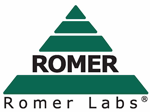Lunch vendor seminar, November 6, 2009 (12:45–14:00)
ELISA Methods Detecting Food Allergens, Mycotoxins and Melamine
Sponsored by 
New Test Kits for fast and reliable Food Allergen Testing
Dipl.-Ing. Elisabeth Halbmayr, Romer Labs Division Holding GmbH, Technopark 1, 3430 Tulln, Austria
A food allergy is typically an immune system response to a protein present in food that the body mistakenly believes is harmful. Common food allergens are gluten-containing cereals, crustaceans, eggs, fish, peanuts, soybeans, lupines, nuts, milk, mustard, sesame, celery, sulphur dioxide, sulphites and molluscs. Food allergies affect 1-3% of the whole population and 5-8% of children. Even minor exposure to a food allergen in the nano-gram range can cause symptoms from mild skin rashes to a fatal anaphylactic shock. Cross contamination during the production process often occurs so residues of food allergens in different products may be present. Testing with the sensitive AgraQuant® Allergen ELISA Test Kits ensures safe food and contributes to consumer protection. The presentation on Food allergen ELISA Test Kits will give an overview of the common ELISA techniques used for detecting food allergens as well as important criteria when using these methods. In the presentation, information about validation process and parameters used for characterization of Test Kits will be provided.
Application of ELISA test kits for mycotoxin analysis
Dr. Eva Wanzenböck, Romer Labs Diagnostic GmbH, Technopark 1, 3430 Tulln, Austria
Mycotoxins are naturally occurring hazards, entering the food chain in the field or during storage, with severe toxic effects on humans and animals. Since this fact is generally agreed upon worldwide, responsible governmental bodies all over the world try to protect their population by setting regulatory limits for the most dangerous mycotoxins.
An overview of the most important mycotoxins and their occurrence, with focus on validation studies of AgraQuant® Mycotoxin ELISA Test Kits and criteria for official Test Kit approvals, is given. The presentation will also give an overview of the sampling and analysing processes for mycotoxins using ELISA technology.
Throwing light on the Melamine issue using ELISA techniques
Dipl.-Ing. Elisabeth Halbmayr, Romer Labs Division Holding GmbH, Technopark 1, 3430 Tulln, Austria
The widespread recall of melamine-contaminated food products - including infant formula in China, chocolates in Australia, pizza cheese in Taiwan, instant coffee in the U.S. and cheese crackers in Hungary – has been worrying consumers all over the world and impressively illustrates the globalization of food supply. Melamine contamination was driven by monetary incentives when unscrupulous traders and producers added melamine to watered-down milk to fool the nitrogen-based standard tests, such as the Kjeldahl and Duma tests, into believing that the product contained more protein than it actually did. Regulatory bodies have set maximum allowed levels of melamine in food stuff and feed. The workshop will give an overview about the methods for detecting Melamine and focus on enzyme-linked immunosorbent assays (ELISA) methods, since this is probably the best alternative for food and feed producers who do not have OR have no access to sophisticated laboratories. A comparative study on several commodities comparing AgraQuant® Melamine ELISA test kits and HPLC methods will be presented.
About the presenters:
Dr. Eva Wanzenböck
Area Manager at Romer Labs®
PhD in Genetics, University of Natural Resources and Applied Life Sciences, Vienna
Degree in Genetics, University of Vienna
Dipl.-Ing. Elisabeth Halbmayr
Product Manager for Rapid Methods at Romer Labs®
Degree in Biotechnology and Food Science, University of Natural Resources and Applied Life Sciences, Vienna
Register for Romer Labs seminar via the on-line Registration form for Vendor seminars & Workshops